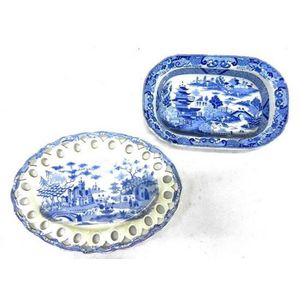Copeland Spode Willow Pattern Dishes, c.1830
Two Copeland Spode Willow Pattern dishes, c.1830, with blue & white transfer print, one with cut out net style rim, diameter 19-23 cm
You must be a subscriber, and be logged in to view price and dealer details.
Subscribe Now to view actual auction price for this item
When you subscribe, you have the option of setting the currency in which to display prices to $Au, $US, $NZ or Stg.
This item has been sold, and the description, image and price are for reference purposes only.
- Willow Pattern - Although several potteries including Minton and Spode claim credit for design of the Willow pattern, the design is generally attributed to Thomas Turner of Caughley Porcelain Works in Shropshire, about 1780.
Whilst borrowing from the Chinese style, it was not a copy of a Chinese pattern.
The blue-and-white chinaware on which it appeared became immensely popular and the design was reproduced with variations by many English and European factories including Royal Worcester, Spode, Adams, Wedgwood, Davenport, Clews, Leeds and Swansea.
It was even copied in Asia, where it is still produced, with the wares being exported to Western countries.
The pattern portrays the garden of a rich mandarin whose young daughter elopes with his secretary. The lovers, overtaken on the bridge by her father, are transformed by the gods into birds and flutter beyond his reach. The scene with its willow tree usually covers the central part of a plate, dish, or bowl, with a border of butterflies, a fret, or other motif.
Traditional Willow pattern is in cobalt blue on white, though very occasionally other colours are used, such as purple or brown. The main part of the object contains the trees, houses, bridge, figures, and birds of the story and there is usually a fairly abstract pattern around the extremities. - Transfer Printed / Decorated Transferware - Transfer printing is method of decorating ceramics, reducing the cost of decoration when compared to employing artists to paint each piece. A print was taken on transfer-paper from an engraved copperplate, covered in ink prepared with metallic oxides, and the image on the paper was then applied to the biscuit-fired ceramic body. The print was fixed by heating the object in an oven, and then glazed, sealing the picture. Early transfer prints were blue and white, as cobalt was the only colour to stand firing without blurring. Early in the 19th century advances in the composition of the transfer paper resulted in better definition and detail, and enabled engravers to combine line-engraving with stipple.
This item has been included into following indexes:
Visually similar items

Antique brass inlaid envelope card table, approx 78 cm high, and 55 cm Sq (closed)
Sold by
in
for
You can display prices in $Au, $US, $NZ or Stg.

A new unopened Hornby R2888M the flying Scotsman train pack consisting of A4 5331 4-6-2 'Kingfisher' & three LNER Gresley teak coaches
Sold by
in
for
You can display prices in $Au, $US, $NZ or Stg.

Hammerli 280 semi automatic target pistol in.22 long rifle calibre. With extra magazine. A superb example. Serial no. 005635 rego 701338080
Sold by
in
for
You can display prices in $Au, $US, $NZ or Stg.

A 19th century cast iron urn, 76 cm high
Sold by
in
for
You can display prices in $Au, $US, $NZ or Stg.
